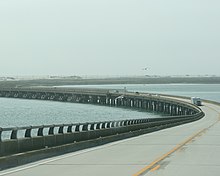Oregon Inlet
| Herbert C. Bonner Bridge | |
|---|---|

Oregon Inlet/Bonner Bridge
|
|
| Coordinates | 35°46′01″N 75°31′38″W / 35.76694°N 75.52722°W |
| Carries |
|
| Crosses | Oregon Inlet |
| Locale | Dare County |
| Other name(s) | Oregon Inlet Bridge Bonner Bridge |
| Named for | Herbert C. Bonner |
| Owner | NCDOT |
| Maintained by | NCDOT |
| Characteristics | |
| Design | Steel stringer |
| Total length | 12,865.8 feet (3,921.5 m) |
| Width | 33.5 feet (10.2 m) |
| Clearance below | 6.6 feet (2.0 m) |
| History | |
| Opened | 1963 |
| Statistics | |
| Daily traffic | 3,700 (as of 2010) |
| References | |
Oregon Inlet is an inlet along North Carolina's Outer Banks. It joins the Pamlico Sound with the Atlantic Ocean and separates Bodie Island from Pea Island, which are connected by the 2.5 mile Herbert C. Bonner Bridge that spans the inlet. As one of the few access points to the ocean along this stretch of coast, Oregon Inlet is a major departure point for charter fishing trips, with a nearby harbor serving as the base for many large boats that travel miles out towards the Gulf Stream almost every day. The inlet is also the location of a U.S. Coast Guard station.
Oregon Inlet was formed when a hurricane lashed the Outer Banks in 1846, separating Bodie Island from Pea Island. One ship that rode out that storm in Pamlico Sound was named the Oregon. After the storm the crew members of this ship were the first to tell those on the mainland about the inlet's formation. Hence, it has been known as Oregon Inlet ever since.
Akin to many other inlets along the Outer Banks, Oregon Inlet moves southward due to drifting sands during tides and storms. It has moved south over two miles since 1846, averaging around 66 feet per year.
The Coast Guard station at Oregon Inlet is currently located at its fourth site since it began as a lifesaving station in 1883. It was one of 29 lifesaving stations Congress approved and appropriated funds for a decade earlier. By 1888, the Oregon Inlet Station had to be relocated to a new site. It is assumed that this relocation was necessary because of the shifting of the channel to the south and the encroachment of the ocean from the east. The station was decommissioned and moved to a new safer location some 400 feet westward toward the sound.
Less than a decade later a storm totally destroyed the Oregon Inlet Station. By 1897, a new station was under construction and was completed in 1898 for less than $7,000. As part of a modernization program in 1933-34, the Oregon Inlet Station was extensively modified to look very much like it does today. In 1979, a new extension was added. By 1988, the station was completely abandoned when the southward migration of the Oregon Inlet threatened to swallow it.
...
Wikipedia
